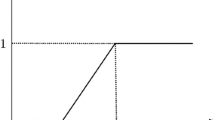Abstract
In this paper, we address a class of bilevel linear programming problems with fuzzy random variable coefficients in objective functions. To deal with such problems, we apply an interval programming approach based on the \(\alpha \)-level set to construct a pair of bilevel mathematical programming models called the best and worst optimal models. Through expectation optimization model, the best and worst optimal problems are transformed into the deterministic problems. By means of the Kth best algorithm, we obtain the best and worst optimal solutions as well as the corresponding range of the objective function values. In this way, more information can be provided to the decision makers under fuzzy random circumstances. Finally, experiments on two examples are carried out, and the comparisons with two existing approaches are made. The results indicate the proposed approaches can get not only the best optimal solution (ideal solution) but also the worst optimal solution, and is more reasonable than the existing approaches which can only get a single solution (ideal solution).

Similar content being viewed by others
References
Allahviranloo T, Nuraei R, Ghanbari M, Haghi E, Hosseinzadeh AA (2012) A new metric for LCR fuzzy numbers and its application in fuzzy linear systems. Soft Comput 16:1743–1754
Ammer EE (2008) On solution of fuzzy random multiobjective quadratic programming with applications in portfolio problem. Inf Sci 178(2):468–484
Anagnostopoulos KP, Petalas C (2011) A fuzzy multicriteria benefit-cost approach for irrigation projects evaluation. Agric Water Manage 98(9):1409–1416
Bard JF (1998) Practical bilevel optimization: algorithms and applications. Kluwer, Dordrecht
Ben-Ayed O, Blair CE (1990) Computational difficulty of bilevel linear programming. Oper Res 38(3):556–560
Bialas WF, Karwan MH (1984) Two-level linear programming. Manage Sci 30(8):1004–1020
Calvete HI, Galé C (2012) Linear bilevel programming with interval coefficients. J Comput Appl Math 236(15):3751–3762
Chinneck JW, Ramadan K (2000) Linear programming with interval coefficient. J Oper Res Soc 51(2):209–220
Colson B, Marcotte P, Savard G (2007) An overview of bilevel optimization. Ann Oper Res 153(1):235–256
Dempe S (2002) Foundations of bilevel programming. Kluwer, Dordrecht
Dempe S (2003) Annotated bibliography on bilevel programming and mathematical programs with equilibrium constraints. Optim J Math Programm Oper Res 52(3):333–359
Kaleva O (1987) Fuzzy differential equations. Fuzzy Sets Syst 24:301–317
Kruse R, Meyer KD (1987) Statistics with vague data. D. Riedel Publishing Company, Dordrecht
Kwakernaak H (1978) Fuzzy random variables-I. definitions and theorems. Inf Sci 15(1):1–29
Li YP, Huang GH (2009) Fuzzy-stochastic-based violation analysis method for planning water resources management systems with uncertain information. Inf Sci 179(24):4261–4276
Liang R, Gao JW, Iwamura KK (2007) Fuzzy random dependent-chance bilevel programming with applications. Lect Notes Comput Sci 4492:257–266
Liu YK, Liu B (2003) A class of fuzzy random optimization: expected value models. Inf Sci 155(1–2):89–102
Luhandjula MK (1996) Fuzziness and randomness in an optimization framework. Fuzzy Sets Syst 77(3):291–297
Luhandjula MK (2006) Fuzzy stochastic linear programming: survey and future research directions. Eur J Oper Res 174(3):1353–1367
Puri ML, Ralescu D (1986) Fuzzy random variables. J Math Anal Appl 114(2):409–422
Rommelfanger H (2007) A general concept for solving linear multicritaria programming problems with crip, fuzzy or stochastic values. Fuzzy Sets Syst 156(17):1892–1904
Sadatia MEH, Nematian J (2013) Two-level linear programming for fuzzy random portfolio optimization through possibility and necessity-based model. Procedia Economics and Finance
Sakawa M, Katagiri H (2012) Stackelberg solutions for fuzzy random two-level linear programming through level sets and fractile criterion optimization. Central Eur J Oper Res 20(1):101–117
Sakawa M, Matsui T (2013a) Interactive fuzzy programming for fuzzy random two-level linear programming problems through probability maximization with possibility. Expert Syst Appl 40(7):2487–2492
Sakawa M, Matsui T (2013b) Interactive fuzzy random cooperative two-level linear programming through level sets based probability maximization. Expert Syst Appl 40:1400–1406
Sakawa M, Matsui T (2013c) Interactive fuzzy random two-level linear programming based on level sets and fractile criterion optimization. Inf Sci 238(20):163–175
Sakawa M, Katagiri H, Matsui T (2011) Interactive fuzzy stochastic two-level linear programming through fractile criterion optimization. Math Comput Modell 54(11–12):3153–3163
Sakawa M, Katagiri H, Matsui T (2012a) Interactive fuzzy stochastic two-level interger programming through fractile criterion optimization. Oper Res 12(2):209–227
Sakawa M, Katagiri H, Matsui T (2012b) Stackelberg solutions for fuzzy random bilevel linear programming through level sets and probability maximization. Oper Res 12(3):271–286
Sakawa M, Katagiri H, Matsui T (2012c) Fuzzy random bilevel linear programming through expectation optimization using possibility and necessity. Int J Mach Learn Cybern 3(3):183–192
Sakawa M, Katagiri H, Matsui T (2012d) Stackelberg solutions for fuzzy random two-level linear programming through probability maximization with possibility. Fuzzy Sets Syst 188:45–57
Talla NF, Guo R (2006) Foundation and formulation of stochastic interval programming. PGD thesis, African Institute for Mathematical Sciences, Cape Town, South Africa
Uno T, Katagiri H, Kato K (2012) A Stackelberg solution for fuzzy random competitive location problems with demand site uncertainty. Intell Decis Technol 6:69–75
Vicente LN, Calamai PH (1994) Bilevel and multilevel programming: a bibliography review. J Global Optim 5(3):291–306
Xu JP, Tu Y, Zeng ZQ (2013) Bilevel optimization of regional water resources allocation problem under fuzzy random environment. J Water Resour Plan Manage 139(3):246–264
Yang J, Zhang M, He B, Yang C (2009) Bi-level programming model and hybrid genetic algorithm for flow interception problem with customer choice. Comput Math Appl 57:1985–1994
Zheng H, Liu JC (2011) Fuzzy newsboy problem with random variables in a supply chain environment. Int J Inf Manage Sci 22:27–42
Acknowledgments
This work was supported by National Natural Science Foundation of China (No.61272119), National Natural Science Foundation of China (No.61203372) and Fundamental Research Funds for the Central Universities (No. K5051303009).
Author information
Authors and Affiliations
Corresponding author
Additional information
Communicated by G. Acampora.
Rights and permissions
About this article
Cite this article
Ren, A., Wang, Y. & Xue, X. An interval programming approach for the bilevel linear programming problem under fuzzy random environments. Soft Comput 18, 995–1009 (2014). https://doi.org/10.1007/s00500-013-1120-9
Published:
Issue Date:
DOI: https://doi.org/10.1007/s00500-013-1120-9



